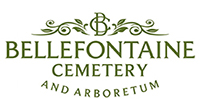In late 2016, Bellefontaine Cemetery and Arboretum Horticulture Supervisor, Kyle Cheesborough, began collaborating with colleagues from the Missouri Botanical Garden to devise a conservation action plan between the two entities. The collaboration resulted in a grant from the American Public Gardens Association to conserve the genetic material from populations of bottlebrush buckeye (Aesculus parviflora) and Arkansas oak (Quercus arkansana).


The bottlebrush buckeye, though common in the nursery trade, is a threatened species occurring in scattered populations in the Southeastern U.S., with little representation for wild populations within public gardens.


Arkansas oak is an endangered species, also occurring in small populations throughout the Southeastern U.S., and with little-to-no wild genetics in maintained collections.
One may ask what purpose a public garden serves for conserving species like the Aesculus parviflora and Quercus arkansana, and the answer is simple. Consider this scenario: a wildfire is out of control and reaches a population of bottlebrush buckeye, a species intolerant of burning. The population is decimated, further threatening the extinction of this rare plant. To re-introduce the bottlebrush buckeye in an appropriate manner, the original genetics of that population should be preserved, therefore any public garden that maintains a collection of A. parviflora collected from the now-burned population can serve as a propagation resource for re-introduction.

Bellefontaine’s Horticulture Supervisor travelled with, Horticulturists Dave Gunn and Jared Chauncey from the Missouri Botanical Garden, in early June 2017 to seek out and collect from as many separate populations as possible to have the best representation of the wild genetics of these species. This included guided hikes through state parks, unguided treks into roadside creeks, preserves, national forests, and other areas in Georgia, Florida, and Alabama. Due to the time of year, the Arkansas oak was scouted for, but not collected from, since the acorns will not ripen until fall. The bottlebrush buckeye, however, has a suckering habit, and these suckers can be dug up and divided from the parent plant. Over 150 divisions of Aesculus parviflora were collected, with great care taken not to disturb or disrupt an individual population’s success.


The two week expedition saw many successful sites, providing ample material for collection. Upon return of the divisions of bottlebrush buckeye and the eventual collection of acorns from the Arkansas oak, the Missouri Botanical Garden will grow this material until it has rooted in well enough to be dispersed to partnering institutions, which include: Bellefontaine Cemetery & Arboretum, the Donald E. Davis Arboretum, Brenton Arboretum, Dawes Arboretum, Mercer Arboretum, Morton Arboretum, and Bok Tower Gardens. This will ensure a number of collections maintained by professional staff, to be utilized in the event of conservation action to preserve and save these two plants.
Bellefontaine Cemetery & Arboretum is committed to the conservation of the natural world, and staff work diligently to preserve plant and animal species both within our 314-acre campus and outside our gates, recognizing our responsibility to develop our green-space in a progressive manner. Cemetery staff will continue to seek work that helps enhance public gardens’ role as conservation hot spots!



compiled by Cara L. Crocker




